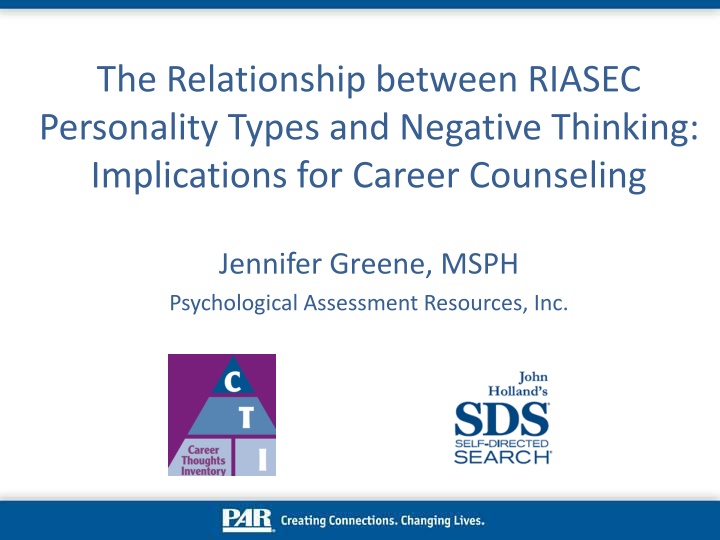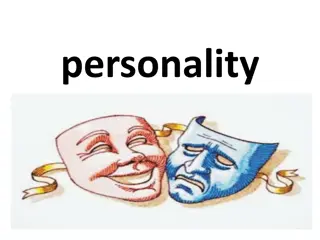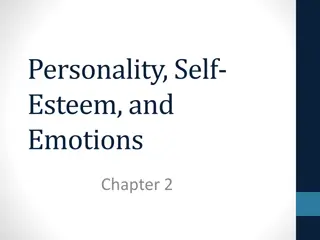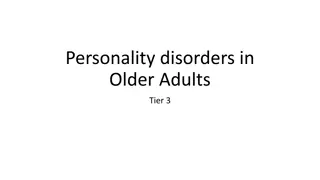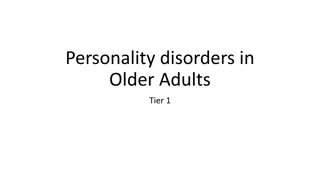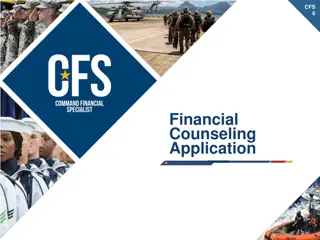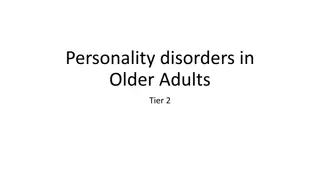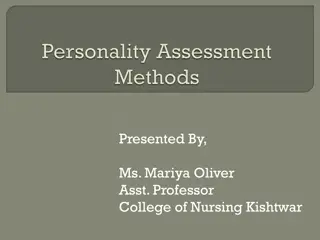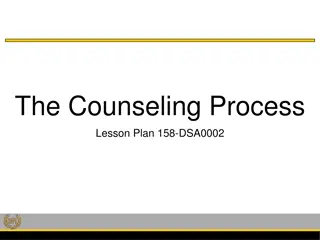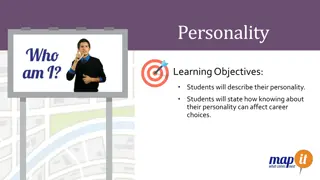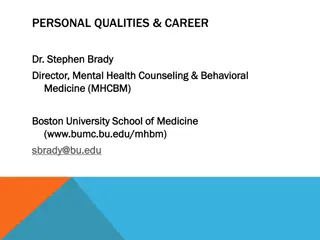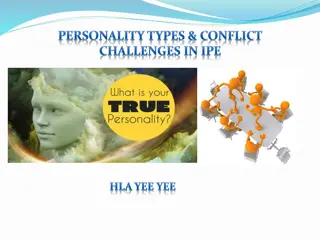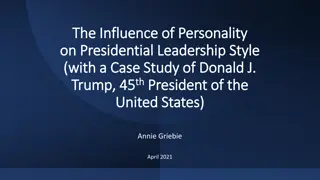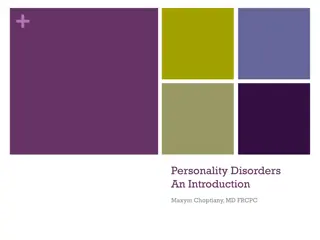The Relationship between RIASEC Personality Types and Negative Thinking: Insights for Career Counseling
Explore the connection between RIASEC personality types and negative career thoughts, utilizing measures like the Self-Directed Search and Career Thoughts Inventory. The study delves into the impact of various personality types on endorsing negative career thoughts, offering implications for effective career counseling interventions.
Download Presentation

Please find below an Image/Link to download the presentation.
The content on the website is provided AS IS for your information and personal use only. It may not be sold, licensed, or shared on other websites without obtaining consent from the author.If you encounter any issues during the download, it is possible that the publisher has removed the file from their server.
You are allowed to download the files provided on this website for personal or commercial use, subject to the condition that they are used lawfully. All files are the property of their respective owners.
The content on the website is provided AS IS for your information and personal use only. It may not be sold, licensed, or shared on other websites without obtaining consent from the author.
E N D
Presentation Transcript
The Relationship between RIASEC Personality Types and Negative Thinking: Implications for Career Counseling Jennifer Greene, MSPH Psychological Assessment Resources, Inc.
My Background Masters of Science in Public Health Doctoral student: PhD in Measurement at the University of South Florida Research and Development Team at Psychological Assessment Resources (PAR) Develop assessments for a wide variety of needs Career Development Also, achievement, intelligence, personality, mood, neuropsychology, speech/language, etc.
Introductions Your background What made you want to come to this presentation?
Agenda Research Objective Hypotheses Measures Used Method Participants Results/Discussion Case Study
Objective To explore the relationship between RIASEC types (as measured by the Self-Directed Search) and negative career thoughts (as measured by the Career Thoughts Inventory)
Hypotheses Hypothesis 1: Low scores on the SDS secondary constructs (congruence, consistency, coherence, differentiation, and profile elevation) are related to higher endorsement of negative career thoughts. Hypothesis 2: Social and Enterprising types are less likely to endorse negative career thinking, and R and C types are more likely to do so.
Measures Self-Directed Search, Fifth Edition (SDS; Holland & Messer, 2013) Career Thoughts Inventory (CTI; Sampson, Peterson, Lenz, Reardon, & Saunders)
Self-Directed Search (SDS) The SDS (Holland & Messer, 2013) is a self-administered career counseling tool. It is divided into four sections: activities, competencies, occupations, and self-estimates. RIASEC - Internet Explorer The top three scores across all sections represent an individual s Summary Code, the three personality types they most resemble.
Realistic (R) types like realistic occupations such as mechanical engineer, landscape gardener, sound technician, cook, exterminator, plumber, locksmith, or safety inspector. They usually have mechanical and athletic abilities, like to work outdoors and with tools and machines, and like to work with things more than people. Investigative (I) types like investigative occupations such as biologist, surgeon, veterinarian, airplane pilot, translator, pharmacist, or actuary. They usually have mathematical and scientific ability, like to work alone, and like to explore and understand things or events rather than persuade others. Artistic (A) types like artistic occupations such as writer, graphic designer, fashion designer, public relations representative, editor, or architect. They usually have artistic skills, enjoy creating original work, and have a good imagination. Social (S) types like social occupations such as teacher, counselor, nanny, librarian, speech therapist, or home health aide. They usually like to be around other people, are interested in how people get along, and like to help, teach, and counsel people more than engage in mechanical or technical activities. Enterprising (E) types like enterprising occupations such as salesperson, contractor, entrepreneur, human resources specialist, lawyer, newscaster, or lobbyist. They usually have leadership and speaking abilities, are interested in money and politics, and like to persuade or direct others more than work on scientific or complicated topics. Conventional (C) types like conventional occupations such as accountant, cashier, fire inspector, data manager, or proofreader. They usually have clerical and math abilities, like to work indoors and organize things, and like to follow orderly routines and meet clear standards, avoiding work that does not have clear directions.
Secondary Constructs Related to Similarity SDS Construct Definition Calculation Degree of fit between a Summary Code and code of current job aspirations Iachan Agreement Index (Iachan, 1984a), ranges from 0 to 28, with higher scores indicating more agreement between the two codes. Congruence High: first two letters of the code are adjacent on the RIASEC hexagon , such as R and C, assigned a score of 3 Average: first two letters are alternate (i.e., neither adjacent nor opposite), such as I and S, assigned a score of 2 Low: first two letters are opposite, such as C and A, assigned a score of 1 Similarity of position of first two code letters on the hexagon Consistency High: first three occupational aspirations have the same first letter, assigned a score of 3 Average: first letter of the first aspiration is also the first letter in the second or third aspiration, assigned a score of 2 Low: first letter of the first aspiration is not the first letter of the second or third aspiration, assigned a score of 1 Degree of similarity between the first letters of the individual s first three listed occupational aspirations Coherence
Secondary Constructs Related to the RIASEC Profile SDS Construct Definition Calculation Shape of the profile of summary scores, i.e., flat or spiked Iachan Differentiation Index (Iachan, 1984b), ranges from 0 to 20, with higher scores indicating more differentiation. Differentiation Overall level of endorsement of items across all domains of the SDS Summing the total number of items endorsed across all RIASEC scales, ranges from 12 to 336, with higher scores indicating higher endorsement across all RIASEC domains. Profile Elevation
Career Thoughts Inventory (CTI) The CTI is a theory-based assessment and intervention resource intended to improve the quality of career services offered. Cognitive information processing (CIP) theoretical approach to career development and career services (Peterson, et al., 1991; Peterson, et al., 1996) Cognitive therapy theoretical approach to mental health and mental health services (Beck, 1976). 10-15 minutes to complete Higher scores indicate higher levels of the scale s measured construct.
CTI Scales The CTI yields a CTI Total score (a single global indicator of dysfunctional thinking in career problem solving and decision making) as well as scores on three construct scales: Decision Making Confusion (14 items) This scale reflects an inability to initiate or sustain the decision making process as a result of disabling emotions and/or a lack of understanding about the decision making process itself. Commitment Anxiety (10 items) This scale reflects an inability to make a commitment to a specific career choice, accompanied by generalized anxiety about the outcome of the decision making process, with the anxiety perpetuating the indecision. External Conflict (5 items) This scale reflects an inability to balance the importance of one s own self- perceptions with the importance of input from significant others, resulting in a reluctance to assume responsibility for decision making.
Background Previous studies (Chason, Bullock-Yowell, Sampson, Lenz, Reardon, 2013; Wright, Reardon, Peterson, & Osborn, 2000) have focused on the relationship between secondary constructs of the Self-Directed Search, Fourth Edition and negative career thoughts as measured by the Career Thoughts Inventory (Sampson, Peterson, Lenz, Reardon & Saunders, 1996). In order to further elucidate the relationship between SDS constructs and negative career thoughts, the current study aims to examine the secondary constructs with the newest edition of the SDS
Method Participants were divided into two groups based on their CTI total T- score. Elevated Independent samples t-tests on mean endorsement of each RIASEC type and mean congruence, consistency, coherence, differentiation and profile elevation. Effect size, Cohen s d, was calculated .20 = small .50 = medium .80 or higher = large Non-Elevated
Participants Characteristic N (%) or M (SD) Elevated 22 A subsample of the SDS Standardization sample (n = 51) Overall 51 Non-Elevated 29 n Gender Male Female Age (years) M SD Range Race/ethnicity Caucasian African American Hispanic Other 26 (51.0) 25 (49.0) 11 (50) 11 (50) 15 (51.7) 14 (48.3) 34.24 17.04 11-69 36.82 19.87 15-69 32.28 14.60 11-69 Both groups were similar in terms of gender, age and racial/ethnic breakdown 22 (43.1) 8 (15.7) 19 (37.3) 2 (3.9) 10 (45.5) 2 (9.1) 9 (40.9) 1 (4.5) 12 (41.4) 6 (20.7) 10 (34.5) 1 (3.4)
Hypothesis 1: Supported The elevated group had lower means on all secondary constructs except for differentiation Congruence, coherence and profile elevation had largest differences medium effect sizes (d=.50, .57, .44, respectively). T-tests = ns, but the trend of the differences were in the right direction Elevated M 14.41 2.18 1.65 6.28 131.86 Non-Elevated M 18.48 2.34 2.05 5.84 149.34 Construct Congruence Consistency Coherence Differentiation Profile Elevation SD 8.13 .73 .70 3.57 33.21 SD 8.42 .67 .74 3.38 45.49 M difference Effect size -4.07 -0.16 -0.40 0.45 -17.48 .50 .24 .57 .13 .44
Hypothesis 2: Supported The elevated group had higher means of endorsement of the Realistic and Conventional types than the non-elevated group. The elevated group had lower means of endorsement of the Social and Enterprising types than the non-elevated group. The groups were significantly different on Conventional Elevated M 18.32 16.64 17.55 23.14 21.73 24.09 Non-Elevated M 16.83 18.48 16.17 23.93 23.66 18.10 Mean difference 1.49 -1.84 1.38 -0.79 -1.93 5.99 SDS Code Type Realistic Investigative Artistic Social Enterprising Conventional SD SD Effect size .11 .17 .11 .06 .19 .60* 14.96 10.76 13.61 12.13 8.37 7.90 12.40 11.54 11.18 12.89 11.25 11.69
Discussion Realistic and Conventional types, as well as those with low scores on the secondary constructs of the SDS, may be more prone to negative career thoughts and may need additional career or personal counseling during the career development process.
Case Study: Bruce college sophomore trying to decide on a major takes the SDS at his university s career center Given his SDS results the fact that Bruce is a Realistic type, he may be prone to negative career thinking His career counselor decides to have Bruce take the CTI as well, to assess his readiness to decide on a major. SDS Results RSA (Realistic, Social, Artistic) Low Low Summary Code Consistency Differentiation Profile Elevation Average CTI Results Scale CTI Total Score Decision-Making Confusion (DMC) Commitment Anxiety (CA) External Conflict (EC) Score 66 58 75 62 %ile 95th 79th 99th 88th
Case Study: Bruce During their next meeting, Bruce confirms the CTI findings and tells his career counselor he is experiencing anxiety across several life domains. SDS Results RSA (Realistic, Social, Artistic) Low Low Summary Code Consistency Differentiation Profile Elevation Average Bruce s career counselor suggests that he seek personal counseling to help alleviate his anxiety, in addition to working with his career counselor to pick a major. CTI Results Scale CTI Total Score Decision-Making Confusion (DMC) Commitment Anxiety (CA) External Conflict (EC) Score 66 58 75 62 %ile 95th 79th 99th 88th
